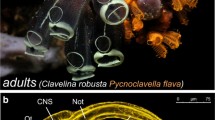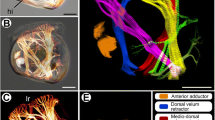Abstract
Patterns of initial muscle formation are well documented for teleost fish. Here, attention is focused upon sturgeons, which arose close to the base of the actinopterygian radiation and whose early development has remained largely unresearched. We demonstrate that some features of muscle development are common to both groups of fish, the most important being the origin and form of migration of adaxial cells to establish the superficial slow fibre layer. This, together with information on initial innervation and capillarisation, strongly suggests a common basis for muscle developmental mechanisms among fish. An important feature that is different between sturgeons and teleosts is that sturgeons lack any cellular dorsal–ventral separation of the myotome that involves the insertion of muscle pioneer (MP)-like cells at the site of the future horizontal septum. This, and information from other fish and from sarcopterygians, permits the supposition that such MP-defined dorsal–ventral separation is a teleost apomorphism. These and other findings are discussed in relation to their significance for the evolution of fish muscle developmental patterns.




Similar content being viewed by others
References
Andersen P, Jensen JKS, Løyning Y (1963) Slow and fast muscle fibers in the Atlantic hagfish (Myxine glutinosa). Acta Physiol Scand 57:167–179
Bajanca F, Luz M, Duxson MJ, Thorsteinsdóttir S (2004) Integrins in the mouse myotome: developmental changes and differences between the epaxial and hypaxial lineage. Dev Dyn 231:402–415
Barresi MJF, Stickney HL, Devoto SH (2000) The zebrafish slow-muscle-omitted gene product is required for hedgehog signal transduction and the development of slow muscle identity. Development 127:2189–2199
Bemis WE, Findeis EK, Grande L (1997) An overview of Acipenseriformes. Environ Biol Fish 48:25–71
Billard R, Lecointre G (2001) Biology and conservation of sturgeon and paddlefish. Rev Fish Biol Fish 10:355–392
Bone Q (1978) Locomotor muscle. In: Hoar WS, Randall DJ (eds) Fish physiology, vol 7. Academic, New York, pp 361–424
Chayen N, Rowlerson AM, Squire JM (1993) Fish muscle structure: fibre types in flatfish and mullet fin muscles using histochemistry and antimyosin antibody labelling. J Muscle Res Cell Motil 14:533–542
Cheng L, Alvares LE, Ahmed MU, El-Hanfy AS, Dietrich S (2004) The epaxial–hypaxial subdivision of the avian somite. Dev Biol 274:348–369
Devoto SH, Melançon E, Eisen JS, Westerfield M (1996) Identification of separate slow and fast muscle precursor cells in vivo, prior to somite formation. Development 122:3371–3380
Devoto SH, Stoiber W, Hammond CL, Steinbacher P, Haslett JR, Barresi MJF, Patterson SE, Adiarte E, Hughes SM (2006) Generality of vertebrate developmental patterns: evidence for a dermomyotome in fish. Evol Dev 8:101–110
van Eeden FJ, Granato M, Schach U, Brand M, Furutani-Seiki M, Haffter P, Hammerschmidt M, Heisenberg CP, Jiang YJ, Kane DA, Kelsh RN, Mullins MC, Odenthal J, Warga RM, Allende ML, Weinberg ES, Nüsslein-Volhard C (1996) Mutations affecting somite formation and patterning in the zebrafish, Danio rerio. Development 123:153–164
Egginton S (2002) Temperature and angiogenesis: the possible role of mechanical factors in capillary growth. Comp Biochem Physiol A 132:773–787
Ekker M, Wegner J, Akimenko MA, Westerfield M (1992) Coordinate embryonic expression of three zebrafish engrailed genes. Development 116:1001–1010
Felsenfeld AL, Curry M, Kimmel CB (1991) The fub-1 mutation blocks initial myofibril formation in zebrafish muscle pioneer cells. Dev Biol 148:23–30
Flood PR, Gulyaev D, Kryvi H (1987) Origin and differentiation of muscle fibre types in the trunk of the sturgeon, Acipenser stellatus Pallas. Sarsia (Bergen) 72:343–344
Gemballa S, Röder K (2004) From head to tail: the myoseptal system in basal actinopterygians. J Morphol 259:155–171
Gemballa S, Hagen K, Röder K, Rolf M, Treiber K (2003) Structure and evolution of the horizontal septum in vertebrates. J Evol Biol 16:966–975
Grimaldi A, Tettamanti G, Martin BL, Gaffield W, Pownall ME, Hughes SM (2004) Hedgehog regulation of superficial slow muscle fibres in Xenopus and the evolution of tetrapod trunk myogenesis. Development 131:3249–3262
Groves JA, Hammond CL, Hughes SM (2005) Fgf8 drives myogenic progression of a novel lateral fast muscle fibre population in zebrafish. Development 132:4211–4222
Hatta K, Bremiller R, Westerfield M, Kimmel CB (1991) Diversity of expression of engrailed-like antigens in zebrafish. Development 112:821–832
Hirsinger E, Stellabotte F, Devoto SH, Westerfield M (2004) Hedgehog signaling is required for commitment but not initial induction of slow muscle precursors. Dev Biol 275:143–157
Isogai S, Lawson ND, Torrealday S, Horiguchi M, Weinstein BM (2003) Angiogenic network formation in the developing vertebrate trunk. Development 130:5281–5290
Johnston IA, Cole NJ, Vieira VLA, Davidson I (1997) Temperature and developmental plasticity of muscle phenotype in herring larvae. J Exp Biol 200:849–868
Kahane N, Cinnamon Y, Kalcheim C (1998) The origin and fate of pioneer myotomal cells in the avian embryo. Mech Dev 74:59–73
Kielbówna L, Daczewska M (2004) Onto-phylogenetic aspects of myotomal myogenesis in chordata. Folia Biol (Kraków) 52:1–12
Killeen JR, McLay HA, Johnston IA (1999) Temperature and neuromuscular development in embryos of the trout (Salmo trutta L.). Comp Biochem Physiol A 122:53–64
Kryvi H, Flood PR, Gulyaev D (1980) The ultrastructure and vascular supply of the different fibre types in the axial muscle of the sturgeon Acipenser stellatus, Pallas. Cell Tissue Res 212:117–126
Liem KF, Bemis WE, Walker WF, Grande L (2001) Functional anatomy of the vertebrates, 3rd edn. Harcourt College Publishers, Philadelphia
López-Albors O, Gil F, Ramírez-Zarzoza G, Vásquez JM, Latorre R, García-Alcázar A, Arencibia A, Moreno F (1998) Muscle development in the gilthead sea bream (Sparus aurata, L.) and sea bass (Dicentrarchus labrax, L.): further histochemical and ultrastructural aspects. Anat Histol Embryol 27:223–229
Maurer F (1894) Die Elemente der Rumpfmuskulatur bei Cyclostomen und höheren Wirbelthieren. Morphol Jahrb 21:473–619
Melançon E, Liu DW, Westerfield M, Eisen JS (1997) Pathfinding by identified zebrafish motoneurons in the absence of muscle pioneers. J Neurosci 17:7796–7804
Moody SA, Jacobson M (1983) Compartmental relationships between anuran primary spinal motoneurons and somitic muscle fibers that they first innervate. J Neurosci 3:1670–1682
Mos W, Williamson R (1986) A quantitative analysis of the spinal motor pool and its target muscle during growth in the dogfish, Scyliorhinus canicula. J Comp Neurol 248:431–440
Myers PZ, Eisen JS, Westerfield M (1986) Development and axonal outgrowth of identified motoneurons in the zebrafish. J Neurosci 6:2278–2289
Osborn M, Weber K (1983) Biology of disease tumor diagnosis by intermediate filament typing. Lab Invest 48:372–394
Pownall ME, Emerson CP (1992) Sequential activation of three myogenic regulatory genes during somite morphogenesis in quail embryos. Dev Biol 151:67–79
Radaelli G, Domeneghini C, Arrighi S, Vaini F, Mascarello F (1999) Histochemical and immunohistochemical investigation of muscle fibres in the sturgeon (Chondrostei; Acipenser). J Appl Ichthyol 15:87–91
Rescan P-Y, Collet B, Ralliere C, Cauty C, Delalande J-M, Goldspink G, Fauconneau B (2001) Red and white muscle development in the trout (Oncorhynchus mykiss) as shown by in situ hybridisation of fast an slow myosin heavy chain transcripts. J Exp Biol 204:2097–2101
Rowlerson AM, Spurway NC (1988) Histochemical and immunohistochemical properties of skeletal muscle fibres from Rana and Xenopus. Histochem J 20:657–673
Roy S, Wolff C, Ingham PW (2001) The u-boot mutation identifies a hedgehog-regulated myogenic switch for fiber-type diversification in the zebrafish embryo. Genes Dev 15:1563–1576
Shook DR, Majer C, Keller R (2004) Pattern and morphogenesis of presumptive superficial mesoderm in two closely related species, Xenopus laevis and Xenopus tropicalis. Dev Biol 270:163–185
Sive HL, Grainger RM, Harland RM (2000) Whole-mount in situ hybridization. In: Sive HL, Grainger RM, Harland RM (eds) Early development of Xenopus laevis. A laboratory manual. Cold Spring Habor Laboratory Press, New York, pp 249–274
Steinbacher P (2004) Patterns of axial muscle formation in actinopterygean fish: a comparative investigation of morphology and expression of muscle specific regulatory genes and structural proteins. Doctoral Thesis, University of Salzburg
Stickland NC, White RN, Mescall PE, Crook AR, Thorpe JE (1988) The effect of temperature on myogenesis in embryonic development of the Atlantic salmon (Salmo salar L.). Anat Embryol 178:253–257
Stickney HL, Barresi MJF, Devoto SH (2000) Somite development in zebrafish. Dev Dyn 219:287–303
Stoiber W (1996) Ontogenesis of axial muscle in teleost fish: an investigation into the source of new muscle fibres and the temperature dependence of growth dynamics. Doctoral Thesis, University of Salzburg
Stoiber W, Sänger AM (1996) An electron microscopic investigation into the possible source of new muscle fibres in teleost fish. Anat Embryol 194:569–579
Stoiber W, Haslett JR, Goldschmid A, Sänger AM (1998) Patterns of superficial fibre formation in the European pearlfish (Rutilus frisii meidingeri) provide a general template for slow muscle development in teleost fish. Anat Embryol 197:485–496
Stoiber W, Haslett JR, Wenk R, Steinbacher P, Gollmann H-P, Sänger AM (2002a) Cellularity changes in developing red and white fish muscle at different temperatures: simulating natural environment conditions for a temperate freshwater cyprinid. J Exp Biol 205:2349–2364
Stoiber W, Haslett JR, Steinbacher P, Freimüller M, Sänger AM (2002b) Tonic fibres in axial muscle of cyprinid fish larvae: their definition, possible origins and functional importance. Anat Embryol 205:113–124
Sunier ALJ (1911) Les premiers stades de la différentiation interne du myotome et la formation des éléments sclérotomatiques chez les acraniens, les sélaciens, et les téléostéens. Tijdschr Ned Dierkundige Vereenig 12:75–181
Vieira VLA, Johnston IA (1996) Muscle development in the tambaqui, an important Amazonian food fish. J Fish Biol 49:842–853
Vieira VLA, Johnston IA (1999) Temperature and neuromuscular development in the tambaqui. J Fish Biol 55(Suppl A):66–83
Waterman RE (1969) Development of the lateral musculature in the teleost, Brachydanio rerio: a fine structural study. Am J Anat 125:457–497
Westneat MW, Wainwright SA (2001) Mechanical design for swimming: muscle, tendon, and bone. In: Block BA, Stevens ED (eds) Tuna. Physiology, ecology and evolution. Fish physiology, vol 19. Academic, San Diego, pp 271–311
Wilkinson DG (1992) Whole mount in situ hybridization of vertebrate embryos. In: Wilkinson DG (ed) In situ hybridization: a practical approach. Oxford University Press, Oxford, pp 75–83
Wolff C, Roy S, Ingham PW (2003) Multiple muscle cell identities induced by distinct levels and timing of hedgehog activity in the zebrafish embryo. Curr Biol 13:1169–1181
Zeller J, Granato M (1999) The zebrafish diwanka gene controls an early step of motor growth cone migration. Development 126:3461–3472
Zeller J, Schneider V, Malayaman S, Higashijima S, Okamoto S, Gui J, Lin S, Granato M (2002) Migration of zebrafish spinal motor nerves into the periphery requires multiple myotome-derived cues. Dev Biol 252:241–256
Zhang J, Granato M (2000) The zebrafish unplugged gene controls motor axon pathway selection. Development 127:2099–2111
Acknowledgements
We thank Hans Bergler, Wöllershof Hatchery, Störnstein, Germany, for providing the sturgeon fry; Pierre-Yves Rescan, INRA Rennes, France, for providing MyHCs cDNA; and Anthea Rowlerson, University of London, UK, for the supply of antibodies. Sincere thanks also to Malgorzata Daczewska of the University of Wroclaw, Poland, for the many fruitful discussions in relation to sturgeon development. Hans-Peter Gollmann (Institute of Water Ecology, Fisheries Biology and Lake Research, Scharfling, Austria) together with Adda Maenhardt, Synnoeve Tholo and Andreas Zankl (all University of Salzburg, Austria) provided excellent technical support. The work was supported by Austrian Science Foundation (FWF) grants P16425 and P14193.
Author information
Authors and Affiliations
Corresponding author
Rights and permissions
About this article
Cite this article
Steinbacher, P., Haslett, J.R., Sänger, A.M. et al. Evolution of myogenesis in fish: a sturgeon view of the mechanisms of muscle development. Anat Embryol 211, 311–322 (2006). https://doi.org/10.1007/s00429-006-0082-4
Accepted:
Published:
Issue Date:
DOI: https://doi.org/10.1007/s00429-006-0082-4




